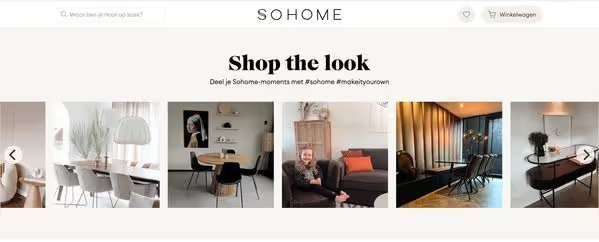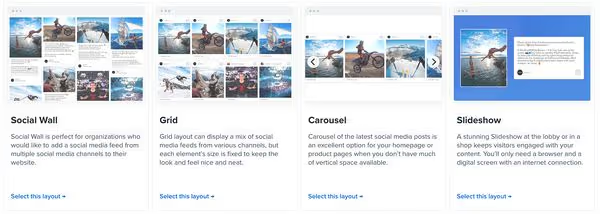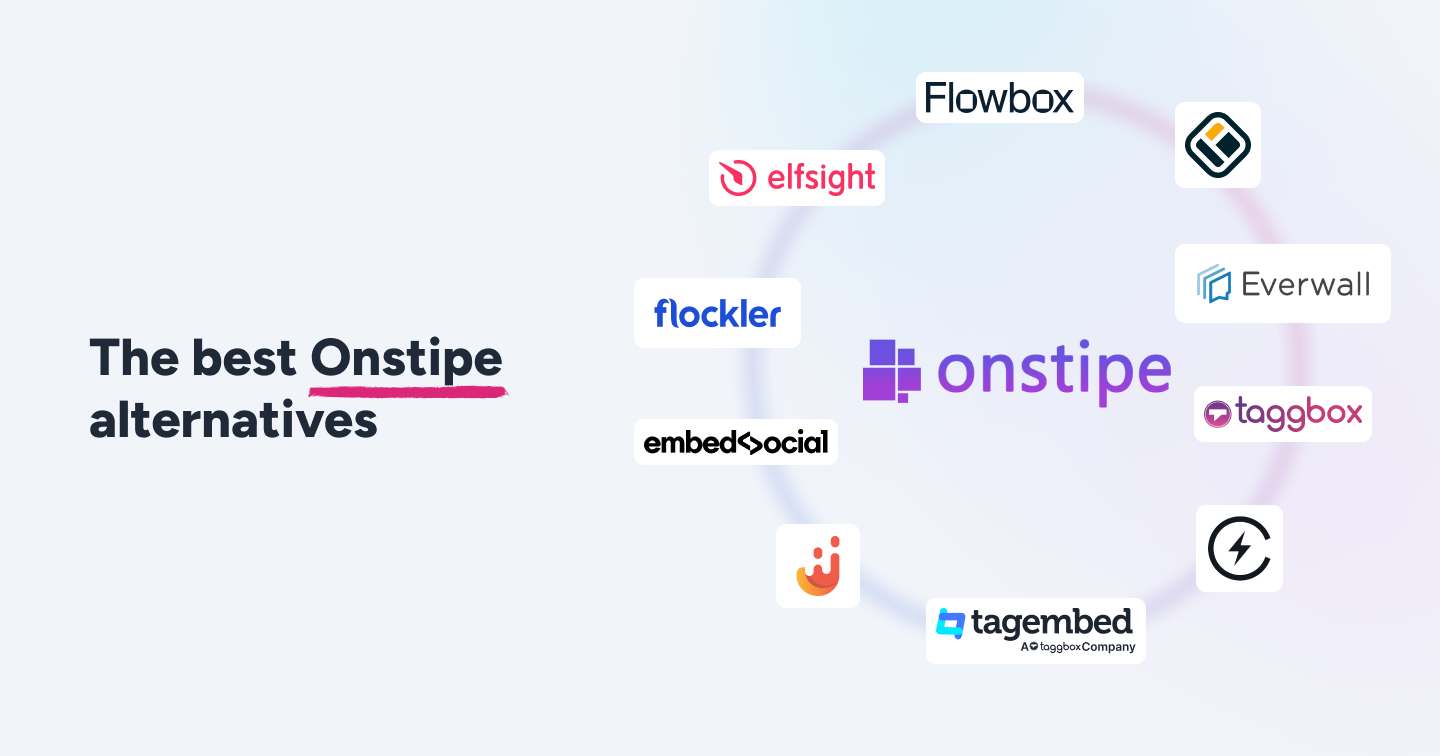Summary
- User-generated content (UGC) is any content created by customers, employees, or fans that brands can showcase to build trust, reach, and conversions.
- Brands like Sohome, Hilton, United Nations Foundation, Philips, and the New Zealand Cricket Team use UGC to attract new audiences.
- UGC works because social platforms prioritize content from friends and real people, making it more engaging than brand-only posts.
- With Flockler, you can easily collect posts via hashtags or mentions and embed shoppable or interactive UGC feeds across websites and digital screens.

Type the name of a place, brand, or product into the Instagram search box, and you’ll get a real-time stream of user-generated content. You’ll find other customers like you enjoying the service or product – you might even find your friends or favourite celebrities in the feed.

User-generated content (UGC) can be defined as content created by customers, employees, partners, influencers, and other business stakeholders, and you don’t typically pay for UGC to be shared online. These days the most popular format of UGC is probably an Instagram image or Reels video but the format can be, for example, text, tweets, Google reviews, or sound files. UGC is not limited to social media channels either; you can gather customer reviews and consumer generated content directly on your website, too.
In this blog post, you’ll find eight fantastic user-generated content campaign examples from:
- Sohome
- Hilton Grand Vacations
- United Nations Foundation
- University of Wisconsin
- Philips
- Worktop Express
- Georgia Power
- New Zealand National Cricket team
Why brands create user-generated content campaigns?

Marketers often describe their goals as building awareness, increasing reach and driving conversions, but in layman’s terms, your job as a marketer is to get the customer to know, like and trust your brand – and eventually, purchase the product and service.
The content you create yourself will definitely help you to build "know, like and trust" factors, but user-generated content and authentic experiences shared by your customers will get a lot more visibility on social media channels.
There’s a reason why – social media algorithms prioritise the posts from our friends and people we interact with regularly. The goal of Facebook, Instagram, X (formerly Twitter), TikTok, and others is to keep you scrolling their feeds for as long as possible - and to get you back there frequently too. From their data, social media channels can see that people spend more time engaging with posts from their friends than posts by brands – and therefore, it makes sense for social media services to prioritise those posts in your news feed.
By creating a user-generated content campaign and engaging your fans in mentioning your branded hashtag or company, you’ll increase reach and awareness for your products and services. Social media posts from friends in our personal feeds spark more likes and comments and your company will find new audiences.
Examples of user-generated content campaigns
It’s always a great idea to learn from others who are getting it right, and here are 8 great examples of user-generated content campaigns:
Sohome
If you have a webshop, a user-generated content campaign is a must-have. Social proof on your homepage and product pages will increase conversation rates.
Include the branded hashtag in all communications; websites, emails, on your blog, and social media. And don’t forget your product packaging and brick and mortar either.
Sohome is one of the many e-commerce sites making UGC shoppable. They engage their customers in sharing product reviews and mentioning the branded hashtag. The best entries are shown on an Instagram carousel on the website.

When a visitor clicks one of the images, a related product is shown – this direct path from social proof to the product page is extremely powerful.

An Instagram feed on a website boosts engagement, increases the number of followers on Instagram, and drives sales.
Have you already created a user-generated campaign for your brand? Create a free trial account with Flockler and gather the latest mentions of your branded hashtag in minutes.
Hilton Grand Vacations

Travel marketers can’t live without user-generated content. And according to research by Travel Counsellors, 96% of travellers are more likely to trust a recommendation from another person over branded content.
Hilton Grand Vacations makes no exception to the rule – their #MyHGV feed features the best Instagram images to inspire website visitors to book the next holiday with them.
For more inspiration, learn how travel brands use social media and UGC in marketing.
United Nations Foundation

In the #EqualEverywhere hashtag campaign, United Nations Foundation asks visitors to take the pledge and join their fight for an equal future. In addition to donations, they ask their fans to use ready-made social media templates and share their message to family and friends.
The campaign is a great example of how nonprofits use socia media for fundraising. Traditional marketing channels (phone calls, street marketing, print advertising, etc.) are still important, but a successful UGC campaign helps organisations to reach new audiences without geographical boundaries - with minimal resources compared to traditional channels and far more precise targeting.
University of Wisconsin

In addition to increasing awareness and reach, the key benefits of using user-generated content in education marketing are to attract future students with social proof and nurture the relationship with existing students, staff, and other stakeholders. Most students these days belong to Generation Z (teens and young adults born in 1995 or later), and compared to previous generations, they value authenticity and are naturally skeptical about advertising.
The University of Wisconsin uses Flockler to gather and display social media feeds on its website – providing students an easy way to share their experiences and add social proof to their website. Some of the advantages of user-generated content are that it saves time from your content creation team and adds social proof to support your existing editorial content.
Philips

Most companies compete on a skilled workforce and sometimes need help finding suitable candidates for open positions. Therefore, fostering the company culture and building a community has become essential in organisations – a strong company culture helps attract a talented workforce.
One of the best ways of fostering a sense of community and belonging among employees is to create a hashtag campaign and show employee-generated content on your websites and other digital platforms. The #LifeAtPhilips hashtag feed on the Our culture page for Philips is a fantastic example of how employees can engage their workforce in creating content. This user-generated content campaign helps Philips tap into the social media network of their employees. What would be a better way to attract talent than posts from your happy employees?
Worktop Express

User-generated content displayed as social proof on product pages increases the time spent on site and drives conversion rates by 20-30% or even more. With other customers similar to us enjoying the product and speaking our language, UGC boosts our trust in the brand and helps us to make the purchase decision.
A long time before the rise of social media channels, print materials and websites have used customer comments and quotes to build trust - and UGC is like reviews on steroids. Social media posts are publicly posted on personal social media feeds and can be updated in real-time.
Worktop Express, the UK’s leading online shop for solid wood worktops, brings user-generated content to the homepage. A beautiful grid of Instagram images is embedded on their homepage to convince visitors to make a purchase.
To scale the volume of user-generated content, add call-to-actions to every customer touchpoint from product packaging to websites and emails.
Does your brand already gather feedback and recommendations from customers? Sign up for a 14-day free trial with Flockler and embed a branded hashtag feed on any digital service.
Georgia Power

I’m sure you’ve noticed that the algorithms of Facebook, X (formerly Twitter), Instagram, and other social media channels promote brands and accounts that receive the highest number of mentions, likes, and comments. It’s in their interest to keep displaying content that our friends like and keep us glued to our screens for long periods of time.
Recognising and promoting your customer community content is an excellent way of increasing the number of mentions. The community page of Georgia Power highlights both the mentions of their Facebook Page and campaign hashtags. By actively curating and promoting the content published by your customers, partners, your brand itself (like Coca Cola does), and stakeholders, you’ll encourage others to participate too.
Have you already created a hashtag campaign for your brand?
New Zealand National Cricket team

Are you running a sports team and don’t have user-generated content from your fans displayed on your site? You must be insane!
Check how New Zealand National Cricket team displays a social media feed with Instagram images, tweets, YouTube videos and more. The team is often mentioned by players, fans and trusted news sources and the social media wall on their site welcomes visitors with a curated feed of this social media content. We haven't met a customer yet where the time spent on site wouldn't increase with the help of a social media wall.
How to embed user-generated content on your website?
Now that you’ve learned why brands are creating UGC campaigns and have seen examples of brands getting it right, I thought it would make sense to show how easy it is to get started and display authentic, user-generated content from your fans on your website.
Embedding social media feeds in any digital service is quick and easy – here’s how you do it:
1. Automatically collect social media posts from various channels
Sign up for Flockler’s 14-day free trial and set up your own rules on which social media channels you’d like to display and what hashtags to use. With automated feeds, the content will be displayed automatically (or stored for moderation), and you can combine multiple social media networks in one feed. Check the list of supported social media channels and content types.
Creating a feed gathering UGC by hashtag, posts mentioning a particular username or posts published by a specific social media account takes a few minutes. Here’s a video to show you how:
2. Moderate your user-generated content campaign
When creating your mix of social media channels, you can decide if the content is displayed on your site automatically or if you store the posts to inbox and moderate the feed one-by one.
Even if you decide to display UGC automatically, you can always hide each post from the social media feed later.

3. Display UGC on websites, mobile apps, emails, digital screens, and more
After creating your stream of UGC content, copy the embed code from your Flockler account and display the campaign content on any website, mobile app, email, digital screen, and any other digital platform. You can choose from four different templates and customize their look & feel without technical skills.

You can create an unlimited social media walls, grids, carousels, and slideshows with the same Flockler account - and with the various filters and options, we enable you to display all of this content or only some of the content anywhere in your digital services and unlimited number of pages. For example, you can display only the content mentioning a specific tag on a dedicated social media campaign or product page.
Have you already created a user-generated content campaign for your brand? Sign up for our 14-day free trial and get started in a few minutes.
FAQs
Why are user-generated content campaigns so effective for brands?
User-generated campaigns collect images and video testimonials from real customers. UGC posts, when added at multiple touchpoints, act as a strong social proof for potential customers. These UGC posts also showcase your product in action, which increases credibility and increases the likelihood of purchase.
How can I encourage customers to participate in a UGC campaign?
To encourage customers to participate in a UGC campaign, brands can either create a hashtag campaign with a relevant hashtag and push that campaign by collaborating with micro influencers. Brands can also incentivize customers with a coupon code or free samples to share their reviews.
What’s the best way to showcase user-generated content?
The best way to showcase user-generated content is to embed these posts on multiple touchpoints such as websites, apps, events, and store screens. Flockler makes it easy to automatically collect, moderate, and display UGC in shoppable and engaging layouts.







